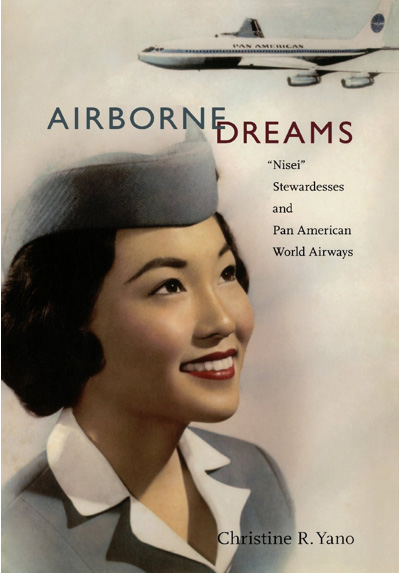 Learning and Writing About the Pan Am Way By Christine R. Yano
Learning and Writing About the Pan Am Way By Christine R. Yano
In April 2005 I noticed a very small announcement in a Honolulu newspaper about a fiftieth-anniversary luncheon being held by former Pan Am "Nisei" stewardesses. I knew nothing about this group of women. However, Pan Am was an entirely familiar name as a famous glamour airline, and one of my cousins had flown for it in the 1960s. As an anthropologist, I was curious about the gathering and about the women. I called the phone number provided, and arranged to meet some of the organizers of that luncheon at a neighborhood Starbucks. The women's stories were so compelling and their enthusiasm for the airline so infectious that I decided that this was a story that needed to be told more broadly.
The result of that afternoon in Starbucks is the book Airborne Dreams: "Nisei" Stewardesses and Pan American World Airways, published by Duke University Press in 2011.
Here is the gist of the story. In 1955 Pan American World Airways began recruiting Japanese American women to work as stewardesses on its Tokyo-bound flights and eventually its round-the-world signature flights. Based in Honolulu, these women were informally known as Pan Am's "Nisei" - second generation Japanese Americans - even though not all of them were Japanese American or second-generation. They were ostensibly hired for their Japanese-language skills, but not all of them spoke Japanese fluently. Instead, I argue that these women were hired to enhance the airline's image of exotic cosmopolitanism and worldliness.In my book, I juxtapose the airline's strategies and practices with the recollections of former "Nisei" flight attendants. Although their stories may be echoed by many other flight attendants who worked for the airline, I note the special place of the Asian (American) woman, as well as the particular significance of Hawai`i in their stories.
The process of researching this story lived under the lucky star that I call the "Pan Am way" - that is, an ongoing network of loyalty and enthusiasm of former Pan Am-ers. Former flight attendants contacted one another about my project, partly through World Wings International, partly through word of mouth. The responses came flooding in. And before six months was over, I had conducted over 35 interviews, as well as received faxes and emails from women supporting my project. With the help of these women, I curated an exhibit at the Japanese Cultural Center of Hawaii entitled "Airborne Dreams" in November 2006. I received a grant from the Smithsonian's National Air and Space Museum to spend a year conducting further research, which I did from 2006 to 2007. During that year, I also spent a couple of weeks at the Pan Am archives housed at the University of Miami. Along the way, I was continually impressed and moved by the generosity of spirit of the extended Pan Am family.
The story is one that continues to be told not only in my book, but also in an exhibit case that I curated at the Smithsonian National Air and Space Museum Steven F. Udvar-Hazy Center, in Washington DC near Dulles Airport. It is a story that has not found much voice in ABC-TV's Pan Am. But it is one that has changed lives profoundly and helped steer the course of global travel to this day.
